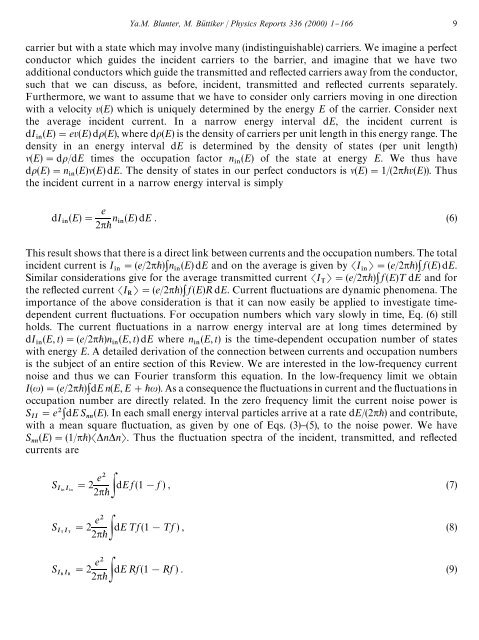shot noise in mesoscopic conductors - Low Temperature Laboratory
shot noise in mesoscopic conductors - Low Temperature Laboratory
shot noise in mesoscopic conductors - Low Temperature Laboratory
You also want an ePaper? Increase the reach of your titles
YUMPU automatically turns print PDFs into web optimized ePapers that Google loves.
Ya.M. Blanter, M. Bu( ttiker / Physics Reports 336 (2000) 1}166 9<br />
carrier but with a state which may <strong>in</strong>volve many (<strong>in</strong>dist<strong>in</strong>guishable) carriers. We imag<strong>in</strong>e a perfect<br />
conductor which guides the <strong>in</strong>cident carriers to the barrier, and imag<strong>in</strong>e that we have two<br />
additional <strong>conductors</strong> which guide the transmitted and re#ected carriers away from the conductor,<br />
such that we can discuss, as before, <strong>in</strong>cident, transmitted and re#ected currents separately.<br />
Furthermore, we want to assume that we have to consider only carriers mov<strong>in</strong>g <strong>in</strong> one direction<br />
with a velocity v(E) which is uniquely determ<strong>in</strong>ed by the energy E of the carrier. Consider next<br />
the average <strong>in</strong>cident current. In a narrow energy <strong>in</strong>terval dE, the <strong>in</strong>cident current is<br />
dI (E)"ev(E)d(E), where d(E) is the density of carriers per unit length <strong>in</strong> this energy range. The<br />
density <strong>in</strong> an energy <strong>in</strong>terval dE is determ<strong>in</strong>ed by the density of states (per unit length)<br />
(E)"d/dE times the occupation factor n (E) of the state at energy E. We thus have<br />
d(E)"n (E)(E)dE. The density of states <strong>in</strong> our perfect <strong>conductors</strong> is (E)"1/(2v(E)). Thus<br />
the <strong>in</strong>cident current <strong>in</strong> a narrow energy <strong>in</strong>terval is simply<br />
dI (E)"<br />
e<br />
2 n (E)dE . (6)<br />
<br />
This result shows that there is a direct l<strong>in</strong>k between currents and the occupation numbers. The total<br />
<strong>in</strong>cident current is I "(e/2)n (E)dE and on the average is given by I "(e/2) f (E)dE.<br />
Similar considerations give for the average transmitted current I "(e/2) f (E)¹ dE and for<br />
the re#ected current I "(e/2) f (E)R dE. Current #uctuations are dynamic phenomena. The<br />
importance of the above consideration is that it can now easily be applied to <strong>in</strong>vestigate timedependent<br />
current #uctuations. For occupation numbers which vary slowly <strong>in</strong> time, Eq. (6) still<br />
holds. The current #uctuations <strong>in</strong> a narrow energy <strong>in</strong>terval are at long times determ<strong>in</strong>ed by<br />
dI (E, t)"(e/2)n (E, t)dE where n (E, t) is the time-dependent occupation number of states<br />
with energy E. A detailed derivation of the connection between currents and occupation numbers<br />
is the subject of an entire section of this Review. We are <strong>in</strong>terested <strong>in</strong> the low-frequency current<br />
<strong>noise</strong> and thus we can Fourier transform this equation. In the low-frequency limit we obta<strong>in</strong><br />
I()"(e/2)dEn(E, E#). As a consequence the #uctuations <strong>in</strong> current and the #uctuations <strong>in</strong><br />
occupation number are directly related. In the zero frequency limit the current <strong>noise</strong> power is<br />
S "edES (E). In each small energy <strong>in</strong>terval particles arrive at a rate dE/(2) and contribute,<br />
with a mean square #uctuation, as given by one of Eqs. (3)}(5), to the <strong>noise</strong> power. We have<br />
S (E)"(1/)nn. Thus the #uctuation spectra of the <strong>in</strong>cident, transmitted, and re#ected<br />
currents are<br />
S "2<br />
e<br />
dEf(1!f ) , (7)<br />
2<br />
S "2<br />
e<br />
dE ¹f (1!¹f ) , (8)<br />
2<br />
S "2<br />
e<br />
dERf(1!Rf ) . (9)<br />
2
















